

After arriving in Tierra del Fuego yesterday afternoon, the expedition team began to plan logistics and prepare equipment today for the first attempt at catching birds for banding. Scouting reports from team members indicated that a flock of about 5,000 red knots had been roosting high on a nearby section of the beach during high tide. Plans were made to set a cannon net (see sidebar) on the beach at 6:30 the following morning in the hopes of catching birds when they landed on the beach to roost. The researchers use a cannon net at high tide when the beach is narrower and the birds are more likely to be found in the area of the net.
Most of the day was divided between scouting for birds, making plastic color bands and flags to band the birds, and preparing the nets and cannons. Patricia Gonzalez, the WASA South American Coordinator, also met with some local residents and teachers and trained them to help with the catch and banding efforts.
What is a cannon net?A cannon net is a large square net that is gathered together in a line parallel to the water and hidden on the sand before the expected birds arrive. Both ends of the net are attached to projectiles which are placed in metal tubes with a gunpowder charge (the cannons) hidden in the sand. The researchers then wait for birds to move into the area that the net will cover. When all is safe for the birds and the researchers, the cannons are fired from a remote switch box, and the projectiles carry the net over the birds, trapping them. |
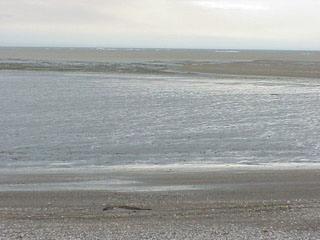 Fig.
1.
1.
Low-tide-Rio-Grande, Tierra del Fuego, Argentina.
Fig.
1.
1.
Low-tide-Rio-Grande, Tierra del Fuego, Argentina.
The area of beach exposed between tides in Rio Grande can differ dramatically.
At high tide, there may be less than 100 feet of beach, while at low tide,
as much as a mile of beach and mud flats may be exposed between the upper beach
and the water. Many species of shorebirds, including red knots, sanderlings, godwits,
curlews, oystercatchers, and white-rumped sandpipers roost in flocks on the upper beach
at high tide, and later move out onto the mudflats and rocky intertidal areas (restingas)
during low tide to feed.
Note the breaking waves in the far distance at the top of the photo.
Photo credit:Eric Simms
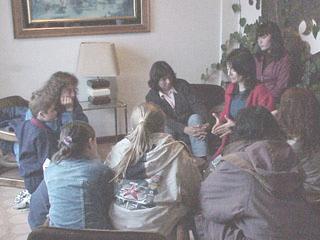 Fig.
1.
2.
Patricia González and volunteers.
Fig.
1.
2.
Patricia González and volunteers.
Patricia González, the WASA South American Coordinator and ISBP researcher, explains the project and catch and banding methods to local teachers and citizen volunteers. Patricia has involved a number of the local teachers in WASA, and these teachers participated in a workshop run recently by Adriana Cafferata as part of the Sister Schools Shorebird Program managed by the U.S. Fish and Wildlife Service. Local volunteers are very important in helping to catch, process and band the captured birds quickly and safely.
Photo credit:Eric Simms
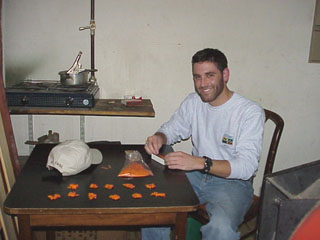 Fig.
1.
3.
Making flags.
Fig.
1.
3.
Making flags.
Eric Simms, the WASA North American Coordinator, helps with pre-catch preparation by making colored flags to be placed on the legs of captured birds. Flags are plastic colored bands with an extra tab that protrudes and identifies the country in which the bird was originally banded. As seen here, orange flags are used for birds originally banded in Argentina. A white flag represents Canada, a blue flag Brazil, and a green flag indicates the United States. Each country along the flyway is represented by a different color or combination of 2 colors.
Photo credit:Patricia González
Members of the expedition team set up the cannon net today at 6:30 a.m. on the beach in Rio Grande in the hopes of trapping some of the 5,000 red knot known to be roosting there during high tide. After several hours of patient waiting the knots arrived on the beach. Humphrey Sitters, a shorebird researcher and licensed cannon netter from England, gave the signal and the net was fired, capturing 194 red knots and 2 hudsonian godwits at 12:33 p.m. local time. This was not an easy feat considering that the temperature on the beach was in the 40's (degrees F) and the wind was blowing continuously between 30-40 mph, with even stronger gusts.
The expedition team and 20 local volunteers worked quickly to extract the birds from the net and place them in holding cages for processing. The birds were weighed and measured, checked for wing moult, carefully banded with metal and color bands and flags, and released to return to their flock.
Included in the captured red knots were 11 birds that had been previously banded (retraps) in 5 different locations in 3 different countries:
Argentina
1 knot banded in San Antonio Este in October 1997
3 knots banded in San Antonio Oeste in March 1998
2 knots banded in Rio Grande in February 1995
United States
2 knots banded in New Jersey in May 1999
2 knots banded in Delaware in May 2000
Brazil
1 knot banded in Lagoa do Peixe in April 1997
These recaptured birds provide valuable information to scientists about the life history and migratory habits of red knots. These banded birds help the researchers understand how long red knots can live, how well they survive, and what habitats and locations are important to their survival along the flyway.
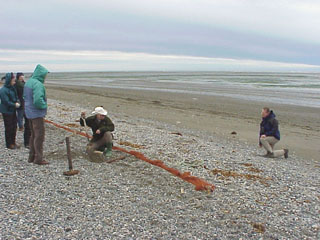 Fig.
2.
1.
Setting Net.
Fig.
2.
1.
Setting Net.
Members of the expedition team set the cannon net on the upper beach prior to high tide. The net is gathered together in a line parallel to the beach, and will be fired if the desired birds visit the area in front of the net. The decision to fire the net must be made carefully to avoid accidentally harming any of the birds. Members of the expedition team always scout an area ahead of time, usually for several days, to be able to set the net in an area that is likely to be visited by the desired birds. Once the net is set, everyone crosses their fingers that the birds will arrive and put themselves in the right location to be easily trapped. Here Humphrey Sitters, a licensed cannon netter from England, eyes up the alignment of the cannon to ensure that the firing goes smoothly.
Photo credit:Eric Simms
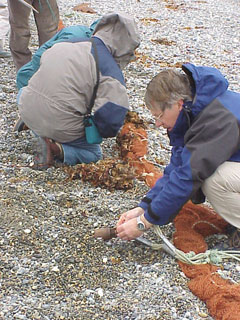 Fig.
2.
2.
Cannon-loading.
Fig.
2.
2.
Cannon-loading.
Humphrey Sitters loads a projectile into one of the two cannons for the cannon net, while other team members disguise the net. The projectile is a heavy metal cylinder that is placed into the cannon and attaches to the net. The cannon is a hollow metal tube with a gunpowder charge in the bottom that is buried in the sand to hide it from the birds. When the birds are in place, a button is pushed on a trigger box by a hidden team member and the projectile is fired from the cannon.
Photo credit:Eric Simms
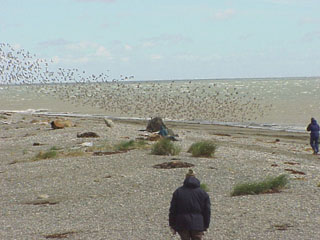 Fig.
2.
3.
Flock-settling.
Fig.
2.
3.
Flock-settling.
A flock of birds prepares to land on the beach where the cannon net has been set by the team. Often, the team has to wait several hours for birds to land in the area of the net. If the birds are roosting on the beach nearby, team members sometimes "twinkle" the birds. Twinkling is when a person slowly walks down the beach in the direction of the net, hoping to move the brds closer to the catch area.
Photo credit:Eric Simms
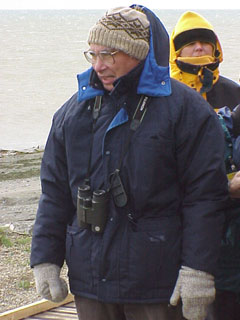 Fig.
2.
4.
Allan Baker.
Fig.
2.
4.
Allan Baker.
Allan Baker, a shorebird researcher from the Royal Ontario Museum and one of the lead International Shorebird Banding Project scientists, braves the cold weather and strong winds with team members and volunteers while he waits for birds to move into the catch area.
Photo credit:Eric Simms
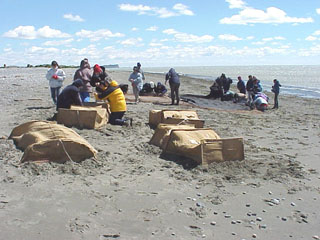 Fig.
2.
5.
Collecting-catch.
Fig.
2.
5.
Collecting-catch.
Once the net is fired, team members and volunteers rush to the net to free the captured birds as quickly as possible. A dark shade cloth is placed over the birds to calm them while team members remove the birds from the net. Volunteer runners carry the birds to holding cages, where they are separated by species and safely held until they can be processed, banded and released.
Photo credit:Eric Simms
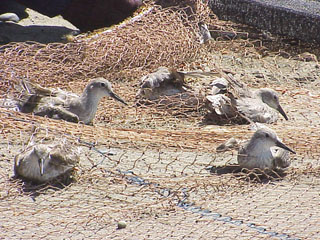 Fig.
2.
6.
Knots in net.
Fig.
2.
6.
Knots in net.
Several red knots in their winter plumage wait their turn to be removed from the net on the beach in Rio Grande. In the background is the black shade cloth used to cover the birds and calm them.
Photo credit:Eric Simms
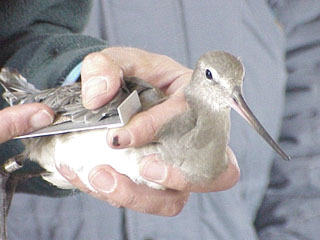 Fig.
2.
7.
Hudsonian godwit.
Fig.
2.
7.
Hudsonian godwit.
A Hudsonian godwit captured on 12/01/00 is processed by David Price, a licensed bander from England. The godwit has received an Instituto Lillo of Tucumán, Argentina metal band on its leg with a unique number imprinted on it that can be used to identify the bird at a later date. Several measurements of the bird will also be taken, including wing length, as seen in the picture.
Photo credit:Eric Simms
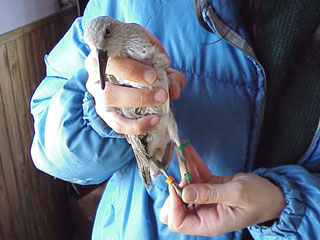 Fig.
2.
8.
Delaware retrap.
Fig.
2.
8.
Delaware retrap.
Patricia González holds a banded red knot that was originally captured and banded at Delaware Bay, Delaware, USA in May of 2000, and was recaptured in the cannon net here. This bird was on its way north to breed in the Canandian arctic when it was captured in Delaware, an has since flown thousands of miles south to winter here in Río Grande, Tierra del Fuego Argentina. That's quite a feat for a bird that normally weighs between 120-220 grams!
Photo credit:Eric Simms
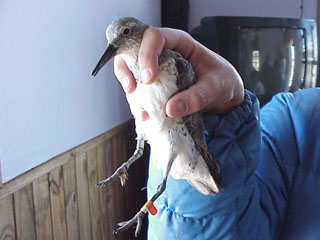 Fig.
2.
9.
Argentinian retrap.
Fig.
2.
9.
Argentinian retrap.
This recaptured red knot was originally banded in San Antonio Este, Argentina in October 1997. San Antonio Este is a town on the Atlantic coast several hundred miles north of Rio Grande. This band combination on this bird tells expedition members that this bird has made the migration from Argentina to the Canadian arctic at least three times! Although the average life expectancy of a red knot is estimated to be less than ten years, some banded knots are known to have lived over 20 years!
Photo credit:Eric Simms
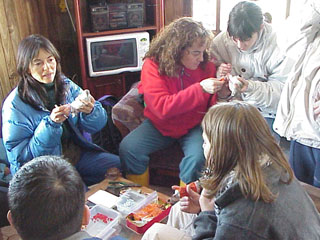 Fig.
2.
10.
Banding-station.
Fig.
2.
10.
Banding-station.
Patricia González places colored bands and flags on the legs of the captured birds with the help of Argentinian volunteers. Many local people from Tierra del Fuego, as well as as other parts of Argentina along the flyway, provide the expedition with very important support. Volunteers help to set up the cannon nets, remove captured birds, and process and band the birds. They are also very important in helping the team to make local arrangements for the expedition. The people of Argentina, including those in Rio Grande and Tierra del Fuego, are extremely friendly and generous. The expedition team has become very good friends with many of the Argentinian volunteers over the years, and made many new friends this year, too. The team would especially like to thank Luis Benegas and the Museo de Historia y Ciencias de Río Grande (Museum of History and Science of Rio Grande) for the invaluable support from their staff, and for the help and accomodations of the staff at Albergue Municipal (Hostel); Silvina Ramírez, Luis Leániz and Gladys Guerrero; Nora Loekemeyer and Miguel Islas, tecnicians from provincial government of Tierra del Fuego; Isla del Mar Hotel; Gomería El Patagón; and all teachers and students from Río Grande.
Photo credit:Eric Simms
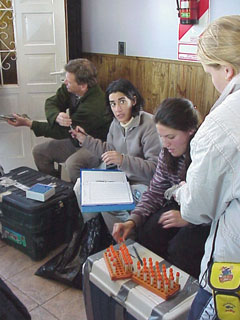 Fig.
2.
11.
Blood and fecal-sampling.
Fig.
2.
11.
Blood and fecal-sampling.
Mark Peck (Royal Ontario Museum), Gabriela "Gabby" Murga (an Argentinian university student), and Anna Yellin (University of Georgia) (left to right) take blood and fecal samples from the captured birds. Mark can use the blood samples to the sex of each knot, and Anna will use the fecal samples to study the distribution of avian influenza over space and time.
Photo credit:Eric Simms
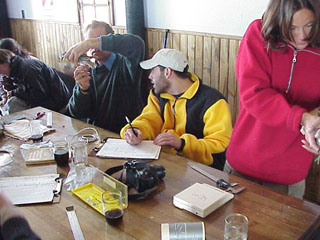 Fig.
2.
12.
Processing-station.
Fig.
2.
12.
Processing-station.
David Price (England), Eric Simms (WASA North American Coordinator, USA), and Verónica D'Amico (an Argentinian university student) work to process the captured birds. Birds are fitted with an individual metal band, checked for wing molt pattern, measured for bill length, and weighed. The birds are then fitted with color bands and flags. Shorebirds molt their flight feathers a few at a time so that they will always have the ability to fly. If they molted them all at once, like some species of geese, they would not be able to fly until all of their new feathers had developed. Checking wing molt helps scientists understand the condition of birds as they migrate, and can help determine if the birds are juveniles or adults.
Photo credit:Allan Baker
| [ Home page ] | [ Maps ] | [ Data entry ] | [ Education ] | [ Contact Us ] |
© 2000 Western Atlantic Shorebird Association